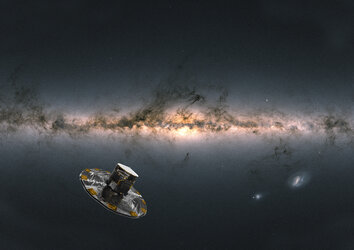Hera’s first images offer parting glimpse of Earth and Moon
ESA’s Hera mission for planetary defence has taken its first images using three of the instruments that will be used to explore and study the asteroids Dimorphos and Didymos.
Following a successful launch on 7 October 2024, Hera’s instruments were switched on for the first time as part of the spacecraft’s ongoing Near-Earth Commissioning Phase. On Thursday 10 October and Friday 11 October, Hera’s asteroid deck, which houses the spacecraft’s instruments, was pointed back towards our planet and three of its instruments captured their first images of Earth and the Moon from a distance of more than one million km.
[A] Asteroid Framing Camera, AFC

Hera’s Asteroid Framing Camera (AFC) captured this farewell image of Earth (bottom left) and the Moon (centre) on 10 October from a distance of approximately 1.6 million km. Earth is oriented with north pointing upwards, with the Pacific Ocean illuminated by the Sun.
Incorporating two baffle-protected cameras for redundancy, each of Hera’s two Asteroid Framing Cameras is a 1020x1020 monochrome visible light sensor. The cameras are used both for navigation and for scientific investigation and were produced by Jena-Optronik in Germany, based on its ASTROhead design.
[B] Thermal Infrared Imager, TIRI

Hera’s Thermal Infrared Imager (TIRI) instrument captured this image of Earth and the Moon from a distance of approximately 1.4 million kilometres. Earth is in the centre of the image and oriented with north pointing upwards, showing the East coast of the USA and the Atlantic Ocean. The Moon is visible in the top right of the image.
TIRI will image the Dimorphos asteroid in the mid-infrared spectral region to chart the temperature on the asteroid’s surface. By charting the 'thermal inertia' of surface regions – or how rapidly their temperature changes – physical properties such as roughness, particle size distribution and porosity can be deduced. TIRI was supplied by the Japan Aerospace Exploration Agency, JAXA, manufactured by Meisei Electric Co. Ltd. and inherited from the instrument onboard the agency’s Hayabusa2 asteroid mission.
[D] HyperScout H

Hera’s HyperScout H instrument captured this false-colour image of Earth and the Moon from a distance of approximately 1.6 million kilometres. Earth (bottom right) is oriented with north pointing upwards, with the Pacific Ocean illuminated by the Sun. The Moon is visible in the top right of the image.
HyperScout H will observe the Dimorphos asteroid in a range of colours far beyond the limits of the human eye and help determine the asteroid’s mineral makeup. The hyperspectral imager covers the 650–950 nm wavelength range, with colours coded so that blue represents the shortest wavelengths and red represents the longest. The shoebox-sized imaging spectrometer was provided by cosine remote sensing in the Netherlands.















 Germany
Germany
 Austria
Austria
 Belgium
Belgium
 Denmark
Denmark
 Spain
Spain
 Estonia
Estonia
 Finland
Finland
 France
France
 Greece
Greece
 Hungary
Hungary
 Ireland
Ireland
 Italy
Italy
 Luxembourg
Luxembourg
 Norway
Norway
 The Netherlands
The Netherlands
 Poland
Poland
 Portugal
Portugal
 Czechia
Czechia
 Romania
Romania
 United Kingdom
United Kingdom
 Slovenia
Slovenia
 Sweden
Sweden
 Switzerland
Switzerland






























